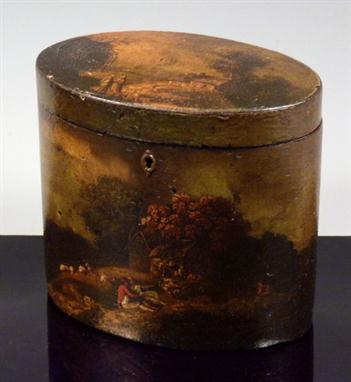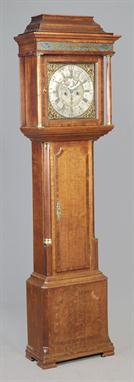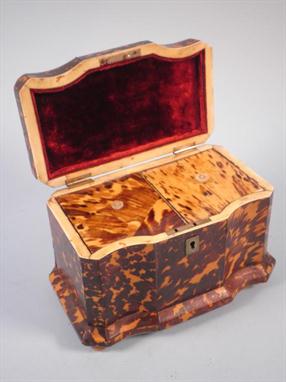We found 81449 price guide item(s) matching your search
There are 81449 lots that match your search criteria. Subscribe now to get instant access to the full price guide service.
Click here to subscribe- List
- Grid
-
81449 item(s)/page
A George III papier mache tea caddy, painted with figures amidst rural scenes with a hinged lid, 11cm high. For a similar caddy (attributed to Henry Clay), see the Nolte Collection, Woolley and Wallis 25th September 2007, lot 158. Also, Christie`s 10th March 2005, lot 72. And `Pictorial Dictionary of Marked London Furniture, 1700-1840`, Christopher Gilbert. Fig. 201 (this one stamped `Clay`). Henry Clay patented his process of laminated panels made from pasted paper sheets in 1772. The business was eventually taken over by Jennens and Bettridge in 1816.
A George III mahogany tea caddy, of oblong form with herringbone edging, the cover with inlay of quarter sunbursts to the corners, a sunburst to the centre, the front inlaid with two conch shells, the three covers to the interior with brass knop handles, with inscription under glass to the cover interior "This chest was made by Richard Smithson in the year 1791, God save the King", 9 1/2" wide
A George III rosewood tea caddy of rectangular form with satinwood line inlaid borders, the hinged cover opening to reveal two lidded covers with key and a George III mahogany tea caddy with banded borders, hinged cover opening to reveal two section compartment complete with key (ILLUSTRATED)
Foreign and plated wares, comprising: a pairs of candle holders, boxed, a Christening beaker and a napkin ring, boxed, a Christening goblet, boxed, three various dish covers, two pairs of asparagus serving tongs, a hinge lidded tea caddy and a pair of stands, formed as stylised Christmas trees.
A French gilt brass carriage clock with push-button repeat and one-piece case Retailed by J. Edmonds, London, mid 19th century The eight-day two train bell striking movement with silvered platform lever escapement and rectangular white enamel Roman numeral dial, in a gilt brass caddy moulded one-piece bevel glazed case with hinged carrying handle, 13cm high excluding handle. DESCRIPTION TO BE READ IN CONJUNCTION WITH ‘IMPORTANT NOTES REGARDING THE CATALOGUING OF CLOCKS’ printed in the sale catalogue or available from the auctioneers on request.
A fine George III mahogany bracket clock Francis Jersey, London, late 18th century The five pillar twin fusee bell striking movement with verge escapement and signed Fran`s Jersey, London to the delicate rococo scroll cartouche and Chinese Chippendale inspired pagoda engraved backplate, the 7 inch single sheet silvered brass Roman numeral break-arch dial with false bob and calendar apertures and repeat signature to the urn and foliate scroll engraved centre, the chapter ring with Arabic five minutes to outer track, the spandrels engraved with further rococo scrolls with the upper spandrels inhabited with Ho-Ho birds and continuing upwards to surround the subsidiary Strike/Silent dial to the arch, the inverted bell-top case with hinged brass carrying handle and pineapple finials above circular and concave-topped rectangular foliate scroll pierced sound frets to sides and caddy mounted angles, the front door with engraved brass quarter frets to the upper quadrants, on cavetto moulded base with brass squab front feet, 46cm (18ins) high excluding carrying handle. DESCRIPTION TO BE READ IN CONJUNCTION WITH ‘IMPORTANT NOTES REGARDING THE CATALOGUING OF CLOCKS’ printed in the sale catalogue or available from the auctioneers on request. Francis Jersey is recorded in Baillie, G.H. Watchmakers & Clockmakers of the World as working in London circa 1770.
A thirty-hour longcase clock Edward Bilbie, Chewstoke, mid 18th century The posted countwheel bell striking movement with brass column turned posts riveted to the top and bottom plates, the 10 inch square brass dial with herringbone border engraved calendar aperture and applied rectangular plaque signed Ed. Bilbie, Chewstoke to centre within an applied silvered Roman numeral chapter ring with fluer-de-lys half hour markers, the angles appled with rococo scroll cast spandrels, now in an oak case with shaped caddy upstand above double frieze and three-quarter columns to hood, rectangular door to trunk and on panel fronted plinth base with moulded skirt, 211cm (6ft11ins) high. DESCRIPTION TO BE READ IN CONJUNCTION WITH ‘IMPORTANT NOTES REGARDING THE CATALOGUING OF CLOCKS’ printed in the sale catalogue or available from the auctioneers on request. Provenance: The family of the late Ernest Hucker. The dial is illustrated in Moore, Rice & Hucker BILBIE and THE CHEW VALLEY CLOCKMAKERS page 303 The clockmaking trade in Chew Stoke was thought to have started around 1695 when the established bell-founder Edward Bilbie I (born 1666) turned his hand to clockmaking. He is thought to have learnt the trade from Edward Webb who worked from the nearby village of Ubley. Bilbie was clearly a talented maker as demonstrated by the remarkable thirty-hour musical longcase clock movement and dial by him included in the exhibition TIME & PLACE 1600-1840 The Antiquarian Horological Society at The Museum of the History of Science, University of Oxford, 25th November 2006 to 15th April 2007 (exhibit number 21). Edward Bilbie had two sons, Edward II (born 1694) who assisted his father but unfortunately died within six months of his father in 1725, and Thomas (born 1702) who inhereted his father`s business in 1725 (see previous lot) and worked until 1768. Edward II had a son which he also named Edward (born circa 1715), who was thought to have been brought up by his uncle, Thomas, and worked alongside him until around 1768. Using the spandrels for dating, the current lot was probably made by Edward Bilbie III during the third quarter of the 18th century. Posted thirty-hour longcase clock movements by the Bilbie family changed very little throughout the entire 18th century with only detail desgn such as the spandrels and chapter ring engraving providing a guide to dating.
A George III mahogany crossbanded oak eight-day longcase clock with moonphase James Whitworth, Lussley, circa 1780 The four pillar rack and bell striking movement with calendar aperture, rolling moonphase and signed J. WHITWORTH, LUSSLEY to the ho-ho bird and foliate scroll engraved centre within an applied silvered Roman numeral chapter ring with leafy half hour markers and Arabic five minutes, the angles with female mask and scroll cast spandrels, the case with ogee-shaped caddy upstand above free-standing columns to hood and shaped top crossbanded door flanked by quarter columns to trunk, on panel-banded plinth base with squat ogee bracket feet, 207cm (6ft 9.5ins) high. DESCRIPTION TO BE READ IN CONJUNCTION WITH ‘IMPORTANT NOTES REGARDING THE CATALOGUING OF CLOCKS’ printed in the sale catalogue or available from the auctioneers on request. James Whitworth is recorded in Baillie, G.H. Watchmakers & Clockmakers of the World as working in Lussley, Lancashire circa 1775.
A black japanned eight-day longcase clock Bearing signature for Samuel Weston, Stratford, mid 18th century and later With later four pillar rack striking movement applied to the 12 inch brass break-arch dial with subsidiary seconds dial and calendar aperture to the matted centre within an applied silvered Roman numeral chapter ring with Fleur-de-lys half hour markers and Arabic five minutes, the angles with Indian mask and scroll cast spandrels within herringbone engraved border, the arch with central silvered boss bearing signature Samuel Weston, Stratford flanked by dolphin mounts within conforming border, in a case with domed caddy above break-arch frieze and three quarter columns to hood, the trunk with break-arch door decorated in raised polychrome and gilt with figures on a bridge within an Oriental garden landscape with a further figure on horseback slaying a dragon to foreground, on conforming plinth base with double skirt (case with some restoration) 242cm (7ft 11.5ins) high. DESCRIPTION TO BE READ IN CONJUNCTION WITH ‘IMPORTANT NOTES REGARDING THE CATALOGUING OF CLOCKS’ printed in the sale catalogue or available from the auctioneers on request.
Victorian silver lockable tea caddy in the form of a stylised octagonal tower with chased Gothic decoration and bead edge, two division interior and domed hinged cover with similar decoration and a gourd shaped knop. Engraved inscription and crest (London 1852), maker Joseph Angell, approximately 18ozs, 19cm overall height
-
81449 item(s)/page
























































